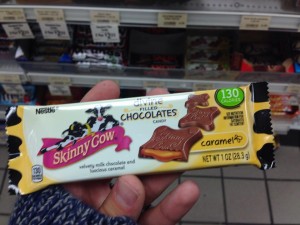 When you first think of a cow, the first word that pops in your head is probably not skinny. In 1994, Nestle added the Skinny Cow brand to their vast food empire. On each product of the Skinny Cow line, the customer views the iconic “skinny cow.” This slender cow, that is actually named Skinny, is meant to show consumers that “great-tasting snacks” do not have to mean you have to eat unhealthily, according to Skinny cow’s website. This particular product that is photographed is their “Divine Filled Chocolates Candy.”
When you first think of a cow, the first word that pops in your head is probably not skinny. In 1994, Nestle added the Skinny Cow brand to their vast food empire. On each product of the Skinny Cow line, the customer views the iconic “skinny cow.” This slender cow, that is actually named Skinny, is meant to show consumers that “great-tasting snacks” do not have to mean you have to eat unhealthily, according to Skinny cow’s website. This particular product that is photographed is their “Divine Filled Chocolates Candy.”
On this package, Skinny is lying on top of a banner of the product name in a quite comfortable and flirtatious manner. She has a tape measurer around her to demonstrate all of the weight she has lost thanks to these delicious snacks. Nestle even took a next step and gave Skinny some mascara, red lipstick, contacts for bright hazel eyes, and a curvy figure. Nestle has anthropomorphized this cow with woman-like features and even a name to relate her to the most-likely woman consumer.
Prior to reading Jonathan Safran Foer’s novel, Eating Animals, I did not really give much thought to the depictions of animals on products. After reading Foer, I looked a little bit deeper and more carefully at the word choices and the entire image of the cow Nestle specifically picked out on the packaging.
Just look at the word “Skinny” in Skinny Cow. Nestle specifically did not choose the word healthy or low-calorie. They chose the word “skinny” for a reason. They wanted customers to give their product a second look as they passed it in the candy and snack aisle. Skinny replaces the over-killed words healthy and low-calorie, representing the aspirations of the modern day woman. Perhaps Nestle also chose to use the word “skinny” because, as Foer points out with the terms healthy, fresh, natural, etc., it allows the company to use words that are associated with positive results to the consumer and positive conditions to the animals, all while actually being not necessarily true. Foer, for instance, demonstrates these misleading labels with the word “fresh.” According to the United States Department of Agriculture, “fresh” poultry refers to poultry that has “never had an internal temperature below 26 degrees or above 40 degrees Fahrenheit” (Foer 61). This example showcases how easy it is for a consumer to assume that their “fresh” poultry refers to something completely different to what it actually is. This does not only stop with “fresh.” This also applies to copious amounts of words including “natural,” and even “skinny”- which most likely has nothing written about in USDA regulations.
If you visit the Skinny Cow website, you will encounter the following text, “Meet Skinny, a.k.a. the goddess of all things delicious and indulgent. She laughs often, lives life to the fullest, and never denies herself a Skinny snack.” After my own general knowledge and reading Eating Animals, I cannot help but have to reread those two sentences a few times. The irony involved is quite apparent. In the United States, where now “Ninety-nine percent of all land animals eaten or used to produce milk and eggs… are factory farmed” (34), I found it hard to believe that these cows that make the milk needed for the Skinny Cow brand have any life that is lived to the “fullest” and consists of laughter.
John Berger points out in About Looking that the Industrial Revolution and capitalism have lead to the reduction of the animal in the food industry: “animals required for food are processed like manufactured commodities” (Berger 13).
Sources:
Berger, John. “Why Look at Animals?” About Looking. New York: Pantheon, 1980. 3-28. Print.
Foer, Jonathan Safran. Eating Animals. New York: Little, Brown, 2009. Print.
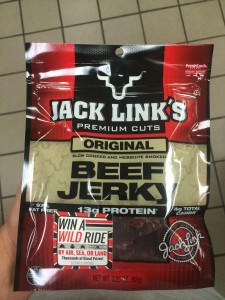
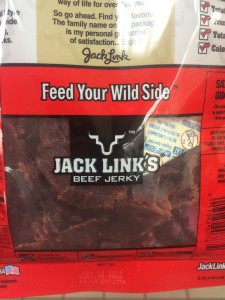 If Jonathan Foer, author of Eating Animals, were to analyze this package, I could assume the numerous assumptions he would make about it. When seeing the image of the animal he would be curious to what type of animal the beef is coming from? As the image seems to depict a bull, he may argue that the company is unsentimental towards animals since we can’t directly identify what animal is in the logo. He could argue the animal may be some other beef processed animal like a cow. He would than most likely question how this animal was farmed, factory or family? Or he might not even bother with that question considering he believes soon enough the term factory farm will fall out for a few reasons. First in his hopes that there will be no more factory farms, or second that there will be no family farms to compare them to. Foer would want to know whether the meat was Kosher or not. Coming from a Jewish heritage and especially the consequences his grandmothers endured during the war, this would be important. Kosher would be defined as that if humans must eat animals, it is done respectfully and free of suffering. Foer would probably agree that along with this package comes a familiar story. Its the same story the male gender has been told about eating meat since we can remember. Eating meat makes you big and strong. I can remember my nonno (italian for grandfather) would always tell me to eat a lot of meat and I will become a strong man like him, then he would flex his arm. Whether its the stories we are told, or what the media projects, eating meat has always been seen as a form of masculinity.
If Jonathan Foer, author of Eating Animals, were to analyze this package, I could assume the numerous assumptions he would make about it. When seeing the image of the animal he would be curious to what type of animal the beef is coming from? As the image seems to depict a bull, he may argue that the company is unsentimental towards animals since we can’t directly identify what animal is in the logo. He could argue the animal may be some other beef processed animal like a cow. He would than most likely question how this animal was farmed, factory or family? Or he might not even bother with that question considering he believes soon enough the term factory farm will fall out for a few reasons. First in his hopes that there will be no more factory farms, or second that there will be no family farms to compare them to. Foer would want to know whether the meat was Kosher or not. Coming from a Jewish heritage and especially the consequences his grandmothers endured during the war, this would be important. Kosher would be defined as that if humans must eat animals, it is done respectfully and free of suffering. Foer would probably agree that along with this package comes a familiar story. Its the same story the male gender has been told about eating meat since we can remember. Eating meat makes you big and strong. I can remember my nonno (italian for grandfather) would always tell me to eat a lot of meat and I will become a strong man like him, then he would flex his arm. Whether its the stories we are told, or what the media projects, eating meat has always been seen as a form of masculinity.
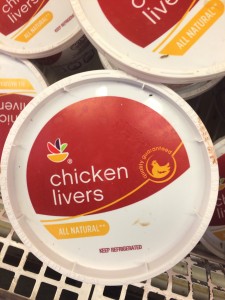 t I have chosen is a container of chicken liver. On the lid and side of the container, there is a picture of a hen sitting there. Above the chicken there is text that reads: “ Quality guaranteed”. The text forms a circle around the hen. I cannot tell if the hen is laying eggs or just sitting there. It is not a photograph. It is a realistic drawing. Right next to the hen, it has the name of the product, “chicken livers”.
t I have chosen is a container of chicken liver. On the lid and side of the container, there is a picture of a hen sitting there. Above the chicken there is text that reads: “ Quality guaranteed”. The text forms a circle around the hen. I cannot tell if the hen is laying eggs or just sitting there. It is not a photograph. It is a realistic drawing. Right next to the hen, it has the name of the product, “chicken livers”.
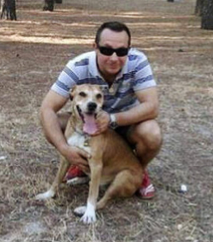
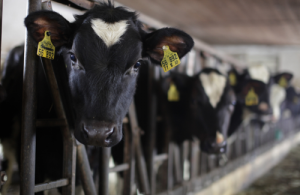
 When you first think of a cow, the first word that pops in your head is probably not skinny. In 1994, Nestle added the Skinny Cow brand to their vast food empire. On each product of the Skinny Cow line, the customer views the iconic “skinny cow.” This slender cow, that is actually named Skinny, is meant to show consumers that “great-tasting snacks” do not have to mean you have to eat unhealthily, according to
When you first think of a cow, the first word that pops in your head is probably not skinny. In 1994, Nestle added the Skinny Cow brand to their vast food empire. On each product of the Skinny Cow line, the customer views the iconic “skinny cow.” This slender cow, that is actually named Skinny, is meant to show consumers that “great-tasting snacks” do not have to mean you have to eat unhealthily, according to
Recent Comments